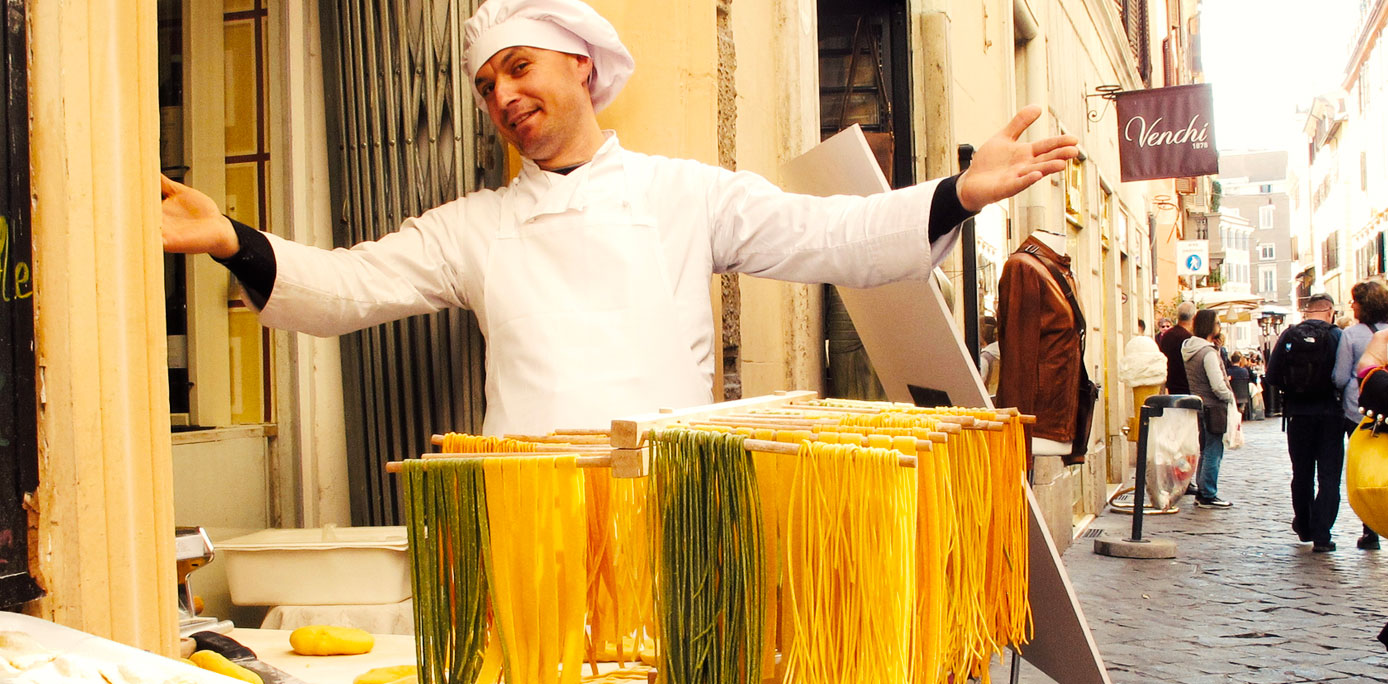There are great love affairs that permeate the ages: Anthony and Cleopatra, Rhett and Scarlet, Samson and Delilah…Everyone and Pasta.
There’s something almost magical about digging into a heaping plate of piping hot noodles slathered in tangy red sauce…or pudgy pasta squares bulging with velvety ricotta. Besides your mother, pasta might actually have been your first love. How many of us began our eating careers gleefully squishing and slurping our way through a bowl of simple spaghetti?
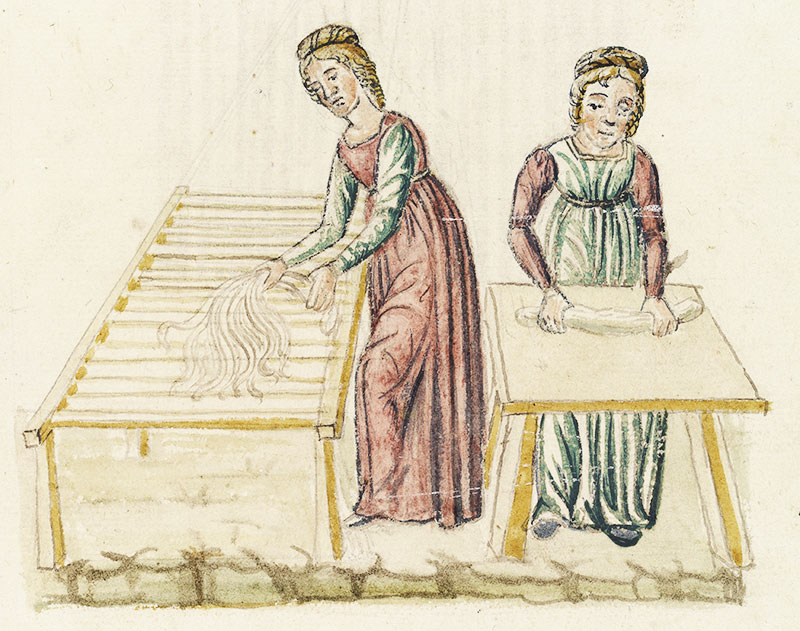
Yesterday, just like today: at work making pasta, sometimes in the Middle Ages
Long, short, skinny, wide, twisted, curled, pinched, tied – pasta in all its glorious forms is ubiquitous to Italy, a food staple that might rank #1 on a list of “What do you think of f when you think of Italy?” And naturally, one assumes the first plate of pasta was introduced to humanity eons ago on the beautiful Italian peninsula. But in actuality, the origin of pasta as we know and love it today is a bit convoluted…a topic still being noodled over in search of a verifiable timeline.
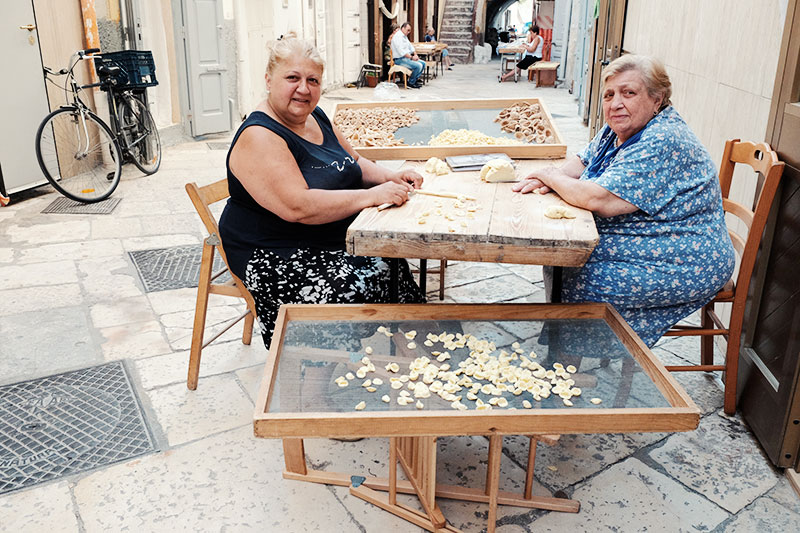
Women at work making fresh pasta in Bari’s old town ©Dreamstime
A long-standing myth says that Venetian explorer Marco Polo returned from his adventures in China in 1295 with pasta in hand, introducing it to his native countrymen. Undoubtedly, Mr. Polo returned with many culinary delights, but evidence is rather plentiful that pasta already existed in Italy by this time and was already gaining popularity during the 13th century. The 1279 will of a Genoan soldier requests a small basket of macaroni, “bariscella piena de macarone” be left to a beloved, certainly referring to the elevated status of pasta some years before Marco’s return.
A look back at ancient China is a good beginning for deciphering pasta’s beginnings. Undoubtedly, noodles made from rice and other flours have been a staple in China and throughout Asia since antiquity. As expeditions and invasions moved westward, so did the noodles.
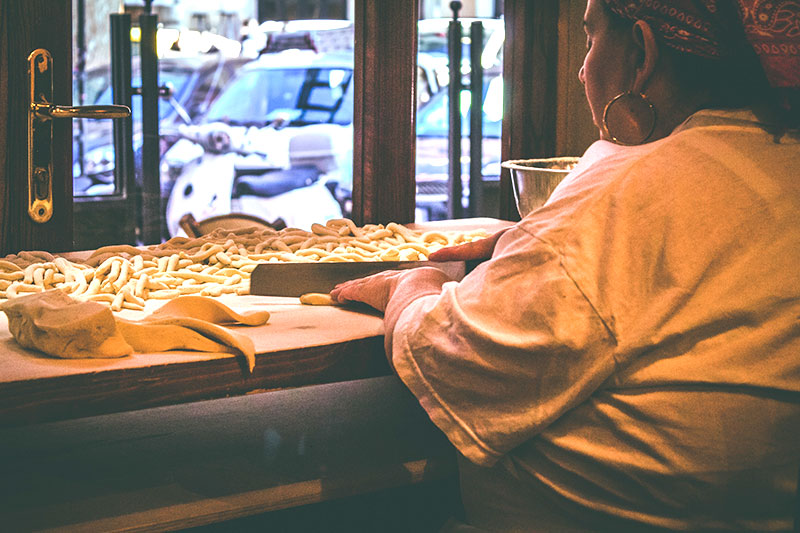
Even if the advent of mechanical production reduced the amount of pasta made by hand, many still love to do it
Although no one knows exactly when the first bowl of chow mein was eaten on European soil, speculation and a little academic input suggest that Arabs originally introduced noodles to the Mediterranean world in the 8th century. Although these noodles were quite different from what we consider pasta today, the Arabic contributions of sauces and spices are still an engrained part of southern Italian culture.
Some like to claim that pasta existed in Italy long before the 8th century, based on a carved relief found in a 4th century BC Etruscan tomb in Cerveteri. Frozen in time, the relief depicts a flour sack, a tool that could plausibly be used for shaping pasta, a board resembling a contemporary pasta board, and a knife – all one needs to make pasta.
Despite the romantic appeal of this interpretation, archeologists have dismissed this oft-repeated and probable urban myth. Based on other digs and comparable research, conclusions strongly suggest that the relief is simply not a pasta how-to for the afterlife.
Molecular archeology has also yet to unveil any evidence of durum wheat, the necessary ingredient for durable pasta, in ancient Etruscan, as well as Roman and Greek, ruins. American culinary historian Charles Perry has explored pasta’s origins and he, too, offers rebuttal: “…no sure Roman reference to a noodle of any kind, tubular or flat, has turned up, and that makes the Etruscan theory even more unlikely…” Though it makes a good story, the evidence begs we toss out the idea that these civilizations discussed the day’s news over a bowl of savory rigatoni.
If it’s fairly safe to say, then, that pasta wasn’t invented in Italy, how has it developed into the one food that passionately embodies Italian cuisine and culture? A look back at the aforementioned Arab introduction of noodles holds the answer.
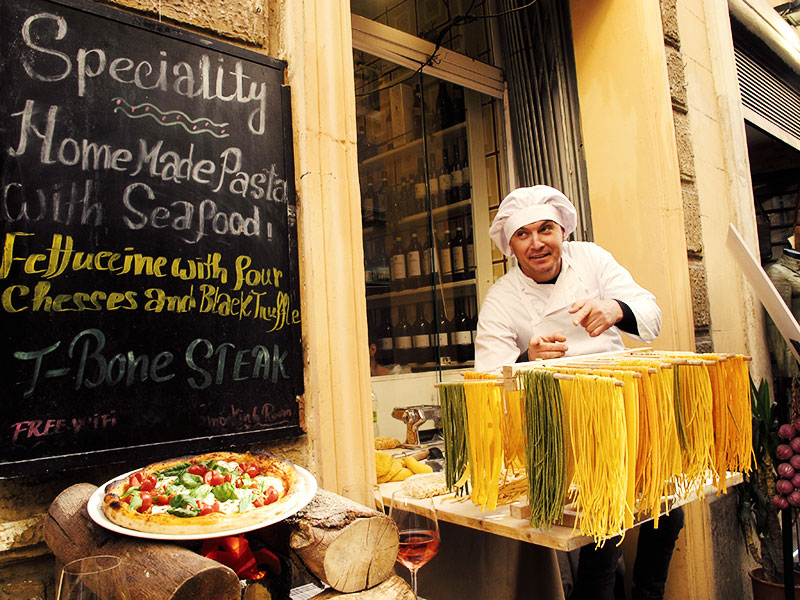
Proud of making fresh pasta! A real Italian tradition, with a history dating back centuries © Lorenzo Daloiso | Dreamstime.com
Though Arab culinary influence was a part of the Sicilian scenery from the 8th century onward, not much changed until the 12th century, when durum wheat made its first known appearance. Necessary for producing a pasta that is sturdy enough to be stretched paper-thin, dry without cracking, and stand up to boiling yet retain a pleasing texture and taste, the availability of durum wheat was a definite game changer.
Sicily and southern Italy’s sunny climate combined with hot, dry volcanic air and cooling sea breezes proved ideal for cultivation of this wheat…and for the new-fangled technique of drying pasta introduced by the Arabs. From Sicily into Campania and onwards to Naples, the elegantly simple combination of durum wheat and water developed into a robust pasta industry with commercial production recorded as far back as the 1400s.
Though popular, pasta was still considered the food of aristocrats and unheard of on a peasant’s plate other than for bits and scraps tossed in soups. Why so? Simply put…labor costs. Tough-as-nails durum wheat had to be pounded endlessly and coaxed into particles delicate enough for creating a dough. Barefoot laborers put feet to dough, sometimes for days, stomping it into submission to be then rolled into sheets. Once suitable, the dough was muscled into presses powered by man and beast as the final product was extruded under great pressure. Overlaid with Arab-influenced sauces combining spicy, sweet, and savory flavors, the rich filled their bellies with the delectable results of this laborious process.
All that changed, however, when mechanical production of pasta came about in Naples in the 1600s. Times were hard, meat and produce were scarce, but wheat was not. Pasta shops blossomed throughout southern Italy. Neapolitans became known as “mangia-maccheroni” – macaroni eaters – who famously shoveled handfuls of noodles from plate to mouth. This new era of easy-access pasta spread quickly throughout Italy. From 1700 to 1785 in Naples alone, pasta shops grew from 60 to 280.
Though it’s hard to imagine pasta minus its sidekick of a savory tomato sauce, this coupling didn’t occur until around 1839 when the first documented recipe appeared. Due to yet another wave of economic hard times, the red fruit once thought to be poisonous was now eaten out of desperation…and oh, the delicious consequence we enjoy because of it! The perfect growing conditions of southern Italy made easy access to abundant fresh produce, and when combined with Italian culinary ingenuity, a wealth of our favorite sauces and pasta dishes came to life.
Even though Italians can’t lay claim to its invention, they can unequivocally claim ownership of Italy’s love affair with pasta and how it is eaten today everywhere in the world, with 84 percent of people worldwide claiming they like Italian food! The average Italian consumes 60 pounds of pasta each year – enough spaghetti to wind around the world about 15.000 times. The verve, passion, and superior quality so intricately a part of Italian food culture lives mightily in pasta; this love affair looks to last forever. Viva la pasta!
Ci sono grandi storie d’amore che permeano i secoli: Antonio e Cleopatra, Rhett e Scarlet, Sansone e Dalila … Noi e la Pasta.
C’è qualcosa che è quasi magico nello scavare in un piatto pieno di fumanti noodles conditi con salsa rossa e piccante… o dentro porzioni di pasta sfoglia piena di ricotta vellutata. Oltre alla mamma, la pasta potrebbe essere stato il vostro primo amore. Quanti di noi hanno iniziato la propria carriera di mangiatori succhiando allegramente o mangiando rumorosamente una ciotola di semplici spaghetti?
Lunga, corta, sottile, larga, attorcigliata, arricciata, pizzicata, annodata: la pasta in tutti i suoi gloriosi formati è onnipresente in Italia, è un alimento di base che potrebbe classificarsi al primo posto nella lista del “Cosa ti viene in mente quando pensi all’Italia?”. Naturalmente, si presume che il primo piatto di pasta sia stato offerto all’umanità, secoli fa, nella bellissima penisola italiana. Ma in realtà, l’origine della pasta, come la conosciamo e amiamo oggi, è un po’ complicata … è un argomento che ancora cerca una cronologia verificabile.
Un antico mito dice che l’esploratore veneziano Marco Polo tornò dalle sue avventure in Cina nel 1295 con della pasta e che la fece conoscere ai suoi connazionali. Indubbiamente, Polo è tornato con molte delizie culinarie, ma ci sono prove piuttosto abbondanti sul fatto che la pasta esistesse già in Italia in quel periodo e che stesse già guadagnando popolarità nel corso del 13° secolo. Il 1279 racconta di un soldato genovese che chiede un cestino di maccheroni, la “bariscella piena de macarone”, da lasciare all’amata, sicuramente facendo riferimento al già elevato stato di notorietà raggiunto dalla pasta alcuni anni prima del ritorno di Marco Polo.
Un’occhiata all’antica Cina è un buon inizio per decifrare gli inizi della pasta. Indubbiamente, le tagliatelle a base di riso e altre farine sono state un punto fermo in Cina e in tutta l’Asia fin dall’antichità. Mentre le spedizioni e le invasioni si spostavano verso ovest, così facevano i loro noodles.
Sebbene nessuno sappia esattamente quando la prima scodella di chow mein sia stata mangiata sul suolo europeo, l’immaginazione e un piccolo contributo accademico suggeriscono che in origine siano stati gli Arabi ad introdurre i noodles nel mondo mediterraneo nell’VIII secolo. Anche se questi noodles erano molto diversi da quelli che oggi consideriamo pasta, il contributo arabo relativamente a salse e spezie è ancora radicato della cultura dell’Italia meridionale.
Ad alcuni piace affermare che la pasta esisteva in Italia molto prima dell’VIII secolo, sulla base di un rilievo scolpito rinvenuto in una tomba etrusca del IV secolo a.C. a Cerveteri. Congelato nel tempo, il rilievo raffigura un sacco di farina, uno strumento che poteva plausibilmente essere utilizzato per modellare la pasta, una tavola che assomigliava ad un tagliere contemporaneo, e un coltello: tutto ciò che serve per fare la pasta.
Nonostante il fascino romantico di questa interpretazione, gli archeologi hanno scartato questo plausibile e spesso ripetuto mito urbano. Sulla base di altri scavi e ricerche comparative, le conclusioni suggeriscono fortemente che il rilievo non sia un modo di preparare la pasta per l’aldilà.
Anche l’archeologia molecolare non ha ancora trovato prove di grano duro, l’ingrediente necessario per fare la pasta, nelle antiche rovine etrusche, romane e greche. Lo storico della gastronomia americana Charles Perry ha esplorato le origini della pasta e anche lui offre una confutazione: “….non c’è alcun riferimento romano certo ad una tagliatella di qualsiasi tipo, tubolare o piatta, e questo rende la teoria etrusca ancora più improbabile….”. Anche se sarebbe una buona storia, le prove ci inducono a scartare l’idea che queste civiltà discutessero dei fatti della giornata davanti a una ciotola di saporiti rigatoni.
Se allora è abbastanza giusto dire che la pasta non è stata inventata in Italia, come è diventata il cibo che incarna con passione la cucina e la cultura italiana? Uno sguardo alla già citata introduzione degli spaghetti ad opera degli Arabi ci dà la risposta.
Sebbene l’influenza culinaria araba sia stata parte del paesaggio siciliano a partire dall’ottavo secolo in poi, non cambiò molto fino al XII secolo, quando il grano duro fece la sua comparsa. Necessario per produrre una pasta abbastanza robusta da essere tirata sottilissima, asciutta senza incrinarsi, e abbastanza resistente da sopportare l’ebollizione pur conservando sapore e una piacevole consistenza, l’avere a disposizione il grano duro è stato determinante.
Il clima soleggiato della Sicilia e del sud Italia combinato con l’aria vulcanica calda e secca e il raffreddamento delle brezze marine, ha dato condizioni che si sono rivelate ideali per la coltivazione di questo grano … e per la nuova tecnica di essiccazione della pasta introdotta dagli Arabi. Dalla Sicilia alla Campania e poi a Napoli, l’elegante e semplice combinazione di grano duro e acqua si è sviluppata in una robusta industria della pasta con una produzione commerciale che risulta risalire al 1400.
Benché popolare, la pasta era però ancora considerata cibo per gli aristocratici, era cosa inaudita nel piatto di un contadino se non per i pezzetti e gli scarti lanciati nelle zuppe. Perchè? In poche parole … costi di manodopera. Il grano duro come la roccia doveva essere macinato all’infinito e fatto a pezzi in particelle abbastanza delicate da creare un impasto. Lavoratori a piedi nudi mettevano i piedi nella pasta, a volte per giorni, calpestandola fino a riuscire ad arrotolarla in fogli. Una volta reso idoneo, l’impasto era lavorato in presse azionate dall’uomo e dalle bestie in quanto il prodotto finale veniva estruso sotto forte pressione. Ricoprendola di salse di influenza araba, che combinavano sapori speziati, dolci e salati, i ricchi riempivano la loro pancia con i deliziosi risultati di questo laborioso processo.
Tutto ciò cambiò, tuttavia, quando la produzione meccanica della pasta incominciò a Napoli nel 1600. I tempi erano duri, la carne e i prodotti erano scarsi, ma il grano no. I negozi di pasta fiorirono in tutta l’Italia meridionale. I napoletani divennero noti come “mangia-maccheroni”: dal piatto alla bocca passavano grandi quantità di noodles. Questa nuova era con una pasta di facile accesso si diffuse rapidamente in tutta Italia. Dal 1700 al 1785, solo a Napoli, i negozi di pasta passarono da 60 a 280.
Sebbene sia difficile immaginare la pasta senza una saporita salsa al pomodoro, questo accoppiamento non c’è stato fino al 1839 circa, quando è apparsa la prima ricetta documentata. A causa dell’ennesima ondata di duri problemi economici, il frutto rosso che un tempo si pensava fosse velenoso cominciò ad essere consumato per disperazione … e oh, è così che oggi abbiamo il delizioso abbinamento! Le perfette condizioni di coltivazione dell’Italia meridionale hanno facilitato la disponibilità di abbondanti prodotti freschi che, una volta combinati con l’ingegnosa arte culinaria italiana, hanno dato forma alla ricchezza delle nostre salse e hanno dato vita ai nostri piatti di pasta preferiti.
Anche se gli italiani non possono rivendicarne l’invenzione, possono inequivocabilmente vantare come propria la storia d’amore tra l’Italia e la pasta come viene mangiata oggi, con l’84% di persone in tutto il mondo che affermano di apprezzare il cibo italiano! L’italiano medio consuma ogni anno 60 chili di pasta: abbastanza spaghetti da girare attorno al mondo circa 15.000 volte. La verve, la passione e la qualità superiore così profondamente parte della cultura alimentare italiana vivono prepotentemente di pasta; e questa storia d’amore sembra possa durare per sempre. Viva la pasta!





